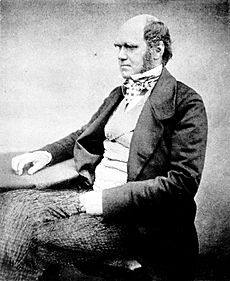Natural selection facts for kids

Natural selection is a main idea in evolution. It was developed by Charles Darwin and Alfred Russel Wallace. Sometimes, people call it "survival of the fittest". Darwin chose the name because it's like artificial selection, which is when humans breed animals or plants for certain traits.
Natural selection is a process where living things with helpful traits are more likely to have babies. When they reproduce, they pass these good traits to their children. Over time, this helps living things adapt to their environment. This happens because genes for helpful traits become more common in the group.
Not all members of a species are exactly alike. This is partly because of differences in their genetics. Even children from the same parents can be different. Some of these differences might help one living thing survive and reproduce better than others in a certain habitat. When this living thing reproduces, it passes on the genes that gave it an advantage. Some adaptations last a very long time, like how birds got wings. Other adaptations are only good if the environment stays the same. If the environment changes a lot, a different living thing might do better.
Contents
How Natural Selection Works
Natural selection helps explain why living things change over time. It shows why they have the bodies, functions, and behaviors they do. Here's how it works:
- All living things can have many babies. This means their numbers could grow very fast.
- But usually, the number of living things in a group stays about the same.
- There isn't endless food or space. So, living things have to compete for what they need.
- No two individuals are exactly the same. Because of this, they don't all have the same chance to live and have babies.
- Many of these differences are passed down from parents to children through genes.
- The next generation comes from those that survive and reproduce. The living things that are best suited to their environment are the ones that survive. After many generations, the group has more helpful genetic differences. It has fewer harmful ones. Natural selection is really a process of elimination.
Examples of Natural Selection
There are many examples of natural selection happening in nature.
Antibiotic Resistance
A clear example of natural selection is how antibiotic resistance grows in tiny living things called microorganisms. Penicillin was found in 1928 by Alexander Fleming. Since then, antibiotics have been used to fight sicknesses caused by bacteria.
Groups of bacteria have many different individuals. They have lots of different genetic material because of mutations. When antibiotics are used, most bacteria die quickly. But some bacteria have mutations that make them a little bit stronger against the antibiotic. If the antibiotic treatment is short, these stronger bacteria will survive. This killing off of weak bacteria is an example of natural selection.
Over time, and with repeated use of antibiotics, a group of bacteria that are resistant will appear. This leads to an "evolutionary arms race". Bacteria keep developing ways to be less affected by antibiotics. At the same time, scientists keep making new antibiotics to kill them. Sometimes, new strains of MRSA bacteria appear that are resistant even to strong new drugs. A similar thing happens with pesticide resistance in plants and insects. It also happens with malaria becoming resistant to quinine.
Camouflage
The peppered moth evolution is a famous example. Most of these moths were light in color. But a few were dark. At first, the light moths survived better. This was because they were camouflaged against the light trees. Birds found it hard to see them.
Then, factories were built. The pollution made the trees turn black. Now, the light moths stood out against the dark bark. The dark moths had the advantage when the environment changed. The genes for dark color spread through the moth population. After the Second World War, rules against pollution made the environment cleaner. Then, the lighter moths again had the advantage. They are now much more common.
Mimicry
Here's another example: Some harmless insects look like other insects that are dangerous or taste bad. This Mimicry evolves because the insects that are better at mimicking survive more often. They live to have more offspring than the ones that are not as good at mimicking. The genes of the better mimics become more common in the species. Over time, species that mimic others look more and more like the ones they are copying. This is the process of evolution by natural selection.
Images for kids
-
Aristotle wondered if different forms of life appeared, and only the useful ones survived.
-
Part of Thomas Malthus's table showing how the population growth in England changed from 1780 to 1810. This is from his book, An Essay on the Principle of Population.
-
Charles Darwin saw that pigeon fanciers had created many kinds of pigeons. These include Tumblers (1, 12), Fantails (13), and Pouters (14). They did this through selective breeding.
-
The peacock's fancy feathers are an example of sexual selection. Females choose mates based on these feathers. This has made the feathers grow very large and colorful over many generations.
See also
 In Spanish: Selección natural para niños
In Spanish: Selección natural para niños






